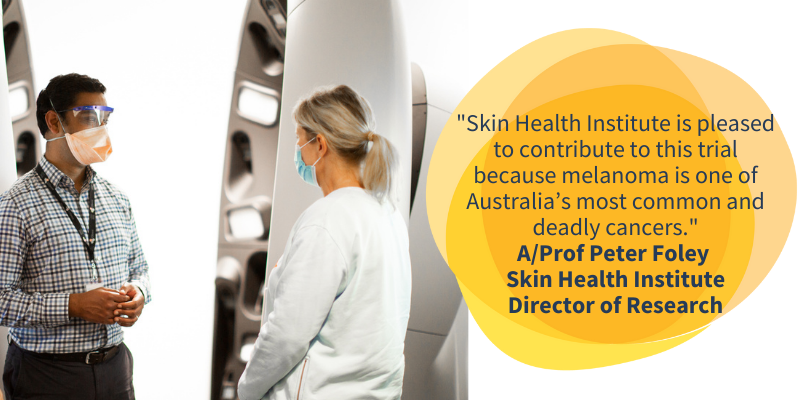A new melanoma clinical trial with a site located in Carlton will examine the effectiveness of Melanoma Surveillance Photography (MSP) – offering state-of-the-art technology aiming to improve surveillance for people at high risk of melanoma.
One of the most important and effective tools in the battle against melanoma is early detection. Identifying and treating melanomas as early as possible is associated with a lower risk of them spreading to other parts of the body.
Melanoma surveillance photography (2D or 3D total body photography with tagged dermoscopy) allows future comparison of suspicious moles to detect early signs of melanoma.
The IMAGE Trial, coordinated by Melanoma and Skin Cancer Trials (MASC Trials), will compare MSP surveillance to clinical monitoring without MSP to determine which method results in fewer unnecessary biopsies in patients at high and ultra-high risk for melanoma.
The trial is now open for recruitment at the Skin Health Institute in Carlton and will enrol up to 80 people for the study.
Skin Health Institute Director of Research, Associate Professor Peter Foley said Skin Health Institute is pleased to contribute to this trial because melanoma is one of Australia’s most common and deadly cancers.
“With such a high incidence of skin cancer in Australia, studies such as the IMAGE trial will play an important role in determining the benefit of melanoma surveillance photography in early detection, which will lead to improved outcomes for patients,” A/Prof Foley said.
One of the Skin Health Institute’s first IMAGE Trial participants is Raema Jackson, who had her first melanoma diagnosis earlier this year.
“I saw the trial on the news and was really keen to be involved. I was going to call my dermatologist the next day, but she called me to ask me if I was interested. I love new technology and I think it is amazing,” Raema said.

The IMAGE Trial is currently enrolling participants across 11 sites in Victoria, New South Wales and Queensland. Regional sites and metropolitan sites are included in the trial to ensure a true representation of melanoma patients in the community and to provide regional residents with more equitable access to breakthroughs in medical care.
Chief Investigator for the trial, Associate Professor Victoria Mar of Monash University, said there was a lack of randomised-controlled trial evidence of MSP’s benefit and cost-effectiveness for patients and the health care system.
“As we don’t have sufficient evidence, MSP is not used routinely during skin examinations as part of ‘standard care’ and is not reimbursed by Medicare. With each imaging session costing around $450, MSP is out of reach for many,” A/Prof Mar said.
To take part, participants must be diagnosed with a primary melanoma and have some or many moles. Participants will be randomly allocated to having either MSP or ‘standard’ clinical surveillance without MSP.
They will continue surveillance with their usual doctor (dermatologist, GP or surgeon) over two years in the community and/or hospital setting, as appropriate. Participants in the control group will be offered 3D imaging at the completion of the trial.
“The high-quality data gathered in this trial will assist the Federal Government’s Medical Services Advisory Committee to decide if MSP should be covered by Medicare, which would provide more Australians with the opportunity to undergo MSP,” A/Prof Mar said.
The IMAGE Trial is funded under the Medical Research Future Fund’s Targeted Health System and Community Organisation Research initiative, sponsored by Monash University, coordinated by MASC Trials, and approved by the Alfred Hospital Ethics Committee.
If you are eligible and interested in participating in the trial, email the Skin Health Institute trial site manager schivers@skinhealthinstitute.org.au or MASC Trials at image@masc.org.au and visit the MASC Trials IMAGE website page.

